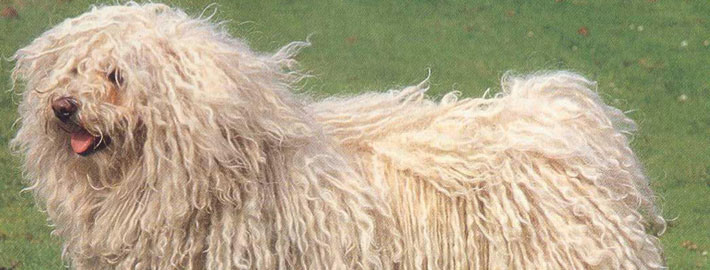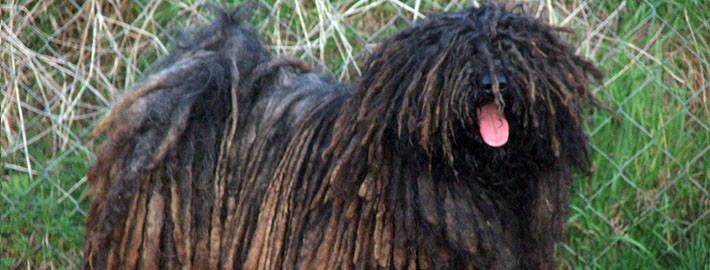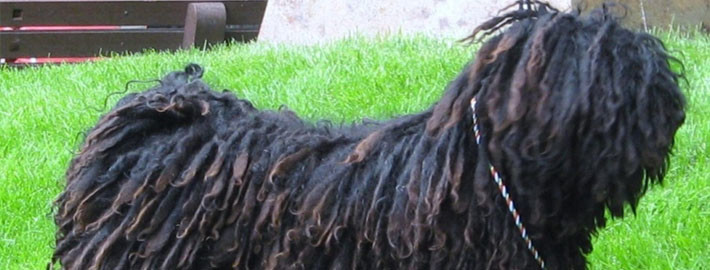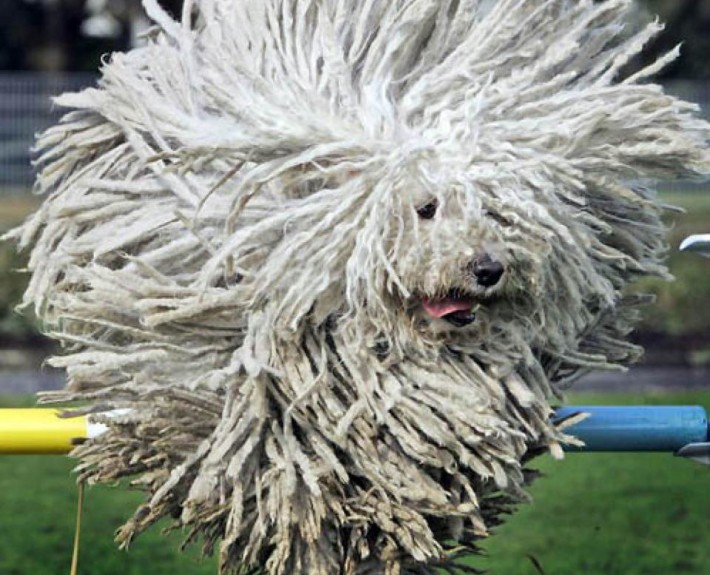What makes the Puli Unique?
Although members of this breed greatly resemble rag mops, Puli dogs are curious bundles of energy. These smart, tough dogs were originally used to herd sheep but are more common as a companion breed these days.
Page Contents
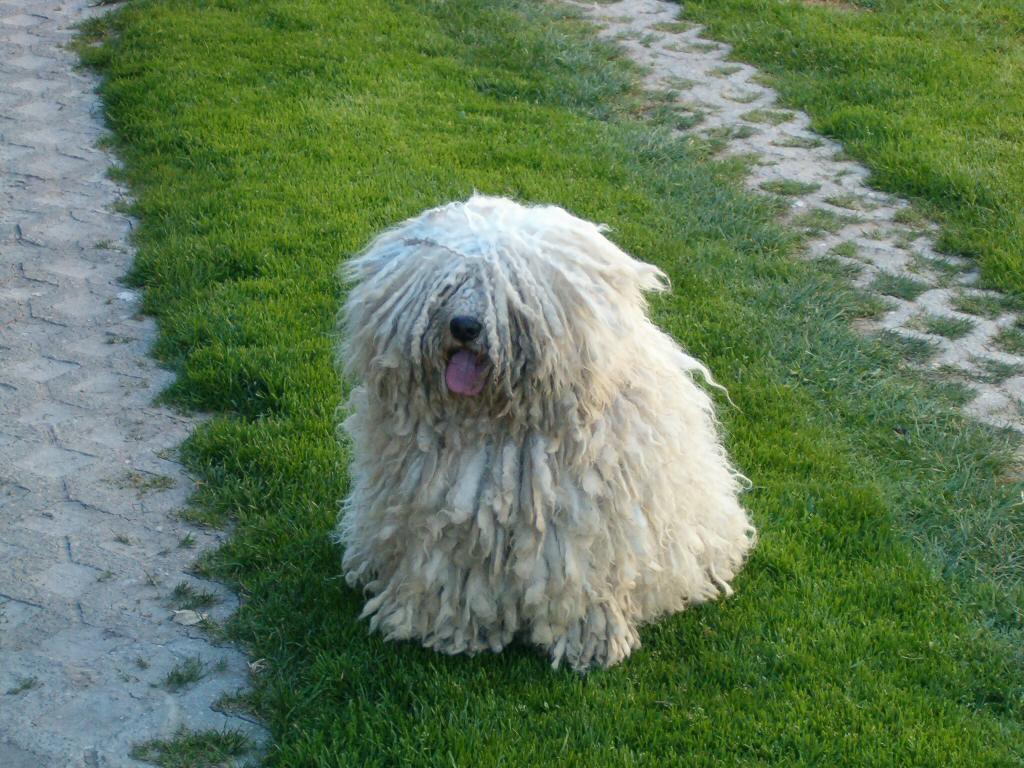
Is the Puli Right For You?
The Puli is a medium sized dog with a sturdy, square body. The lavish coats on these dogs mostly cover their facial features. These dogs generally have dark brown eyes, black noses, and black or grey nails.
They are joyful, humorous, and intelligent, these dogs exhibit puppy like characteristics for much of their lives. They can be quite affectionate. Pulik nonetheless make excellent guard and watch dogs for various types of livestock. These vocal dogs tend to bark a lot and can sound incredibly vicious, though they are completely loyal to their human family members.
These dogs benefit greatly from early socialization, which helps them distinguish between strangers that are friendly and those that are a threat. Members of this energetic breed especially enjoy playtime if their human family members join in. These dogs have also been known to climb high fences and, therefore, will need to be carefully monitored even when playing in a safely enclosed area.
In 5 Words
- Agile
- Loyal
- Energetic
- Obedient
- Faithful
Characteristics
Learn About the Puli
Description
General Description
Noteworthy for its thick and shaggy coat, the Puli is a medium sized dog with a sturdy, square body. The lavish coats on these dogs mostly cover their facial features. These dogs generally have dark brown eyes, black noses, and black or grey nails. Their dewclaws are generally removed. Members of this breed have a brisk gait and can easily change directions. Their movements are rapid but agile. Their curved tails are carried over their backs.
Size
Both male and female dogs should weigh between 25 and 35 kilograms. Ideally, male dogs should stand approximately 17 inches at the withers or shoulder blades and female dogs should be 16 inches tall.
Coat
Puli dogs have a double layered, weather proof coat that is fully developed by the time they reach five years old. The thick, soft inner layer is covered by an outer coat that is either curly or wavy and typically forms cords. These cords will vary in texture, depending on the individual dog. Thinner, finer cords are considered more desirable on show animals. Owners can also brush out their dog’s fur or keep their pet clipped if they prefer to do so. Acceptable coat colors for this breed include black, white, and grey.
Short History of the Puli
Over a thousand years ago, the ancestors of modern Puli dogs came with the Magyars tribes when they moved into the area that is now Hungary. These people valued their sheep herding dogs very highly but the Puli breed nearly went extinct in the 16th and 17th centuries due to the breeding practices of the time. These dogs initially came in four different sizes but the medium variety was the most popular and that is the one which served to form the current breed standard. They slowly moved from being farm dogs to being family pets. In the early 1900s, a moderately successful effort was made to revive the breed. The breed standard was approved by the Fédération Cynologique Internationale (FCI) in 1924 and twelve years later these dogs were admitted to the American Kennel Club.
Temperament
Joyful, humorous, and intelligent, these dogs exhibit puppy like characteristics for much of their lives. They can be quite affectionate. Pulik nonetheless make excellent guard and watch dogs for various types of livestock. These vocal dogs tend to bark a lot and can sound incredibly vicious, though they are completely loyal to their human family members. Pulik get along with children and other pets if they are brought up around them. These dogs also see it as their duty to protect their homes. As a result, they can be aggressive towards other canines and wary of strangers. Due to their pronounced herding instincts, these dogs have been known to bite. Obedience training is recommended to help owners keep these unfavorable traits under control and Puli dogs are relatively easy to teach due to their long history as a working breed.
Caring for Your Puli
General Health
Born in litters of about 5 to 6 puppies, these typically healthy dogs live about 14 years on average. However, hip dysplasia and progressive retinal atrophy remain serious breed concerns. Hip dysplasia is problematic in most breeds but Pulik seem to have a higher predisposition to this joint-related ailment than other dogs do. Once a dog reaches about a year old, their vet can and should test their hip joints for any signs of the problem. Remedial treatments are available. There are a number of genetic diseases that fall under the banner of progressive retinal atrophy but the end result is usually the same. Dogs who suffer from these problems can go blind. It is not a treatable condition.
Care
Daily
A briskly paced walk or jog is sure to appeal to these dogs, because members of this breed need moderate amounts of exercise every day.
Weekly
Pulik whose owners do not want them to have corded coats should brush their dogs every other day if they do not wish to groom them on a daily basis.
Monthly
All dogs need flea, tick, and heartworm prevention medication on a regular basis. Most products on the market are designed to be applied once a month for best results.
Grooming & Bathing
Owners that do not wish to have their dogs clipped should note that the corded coat style requires a substantial amount of maintenance. Naturally corded coats will need to be hand separated in order to remove both dirt and debris on a frequent basis. This style also tends to become waterlogged after a Puli has been bathed, sometimes taking as long as a few days to completely dry out. Mildew can set in if these dogs are not properly dried. Despite this fact, members of this breed need to be bathed regularly to prevent their coats from becoming infested with ticks or fleas. Therefore, it might be a good idea for owners to blow their pets dry using an electric hairdryer after they’ve been washed. Owners will also need to clean their dog’s eyes and ears on a regular basis to prevent infections from occurring.
Exercise & Training
Training Puli dogs requires a consistent and firm approach. While the dogs are quite intelligent, they also can be stubborn at times. These dogs benefit greatly from early socialization, which helps them distinguish between strangers that are friendly and those that are a threat. Members of this energetic breed especially enjoy playtime if their human family members join in. A number of Pulik are good swimmers and enjoy the water. However, not all member of this breed possess this characteristic so owners should supervise these dogs when they are around water until they are sure their pet can manage. These dogs have also been known to climb high fences and, therefore, will need to be carefully monitored even when playing in a safely enclosed area.

